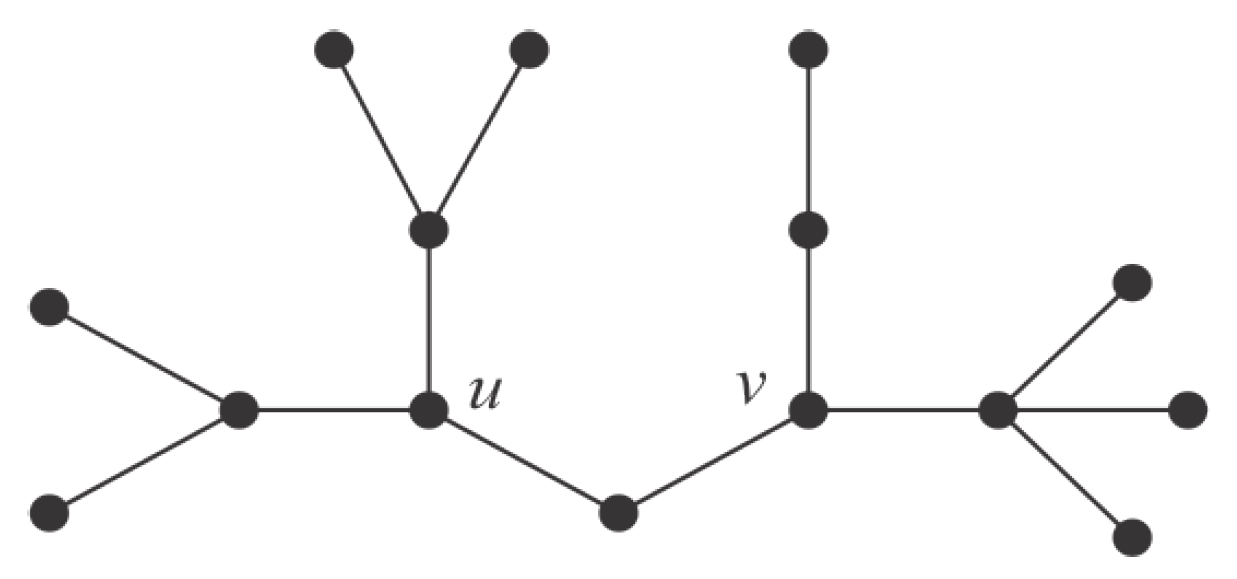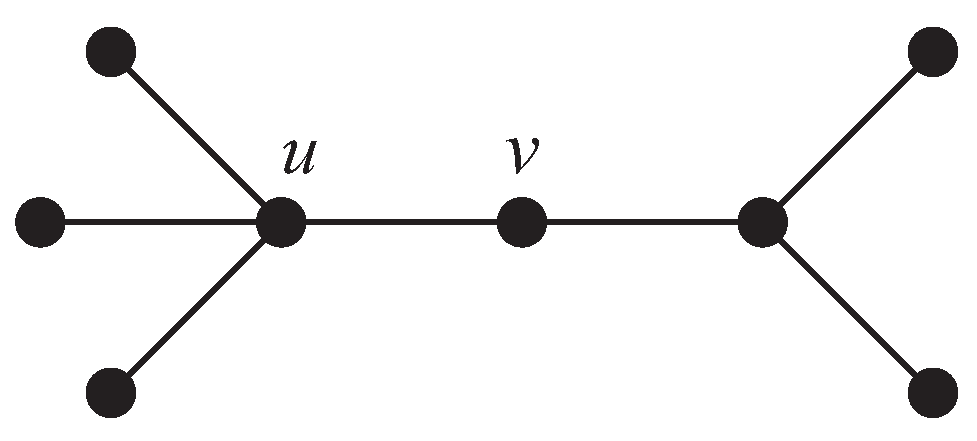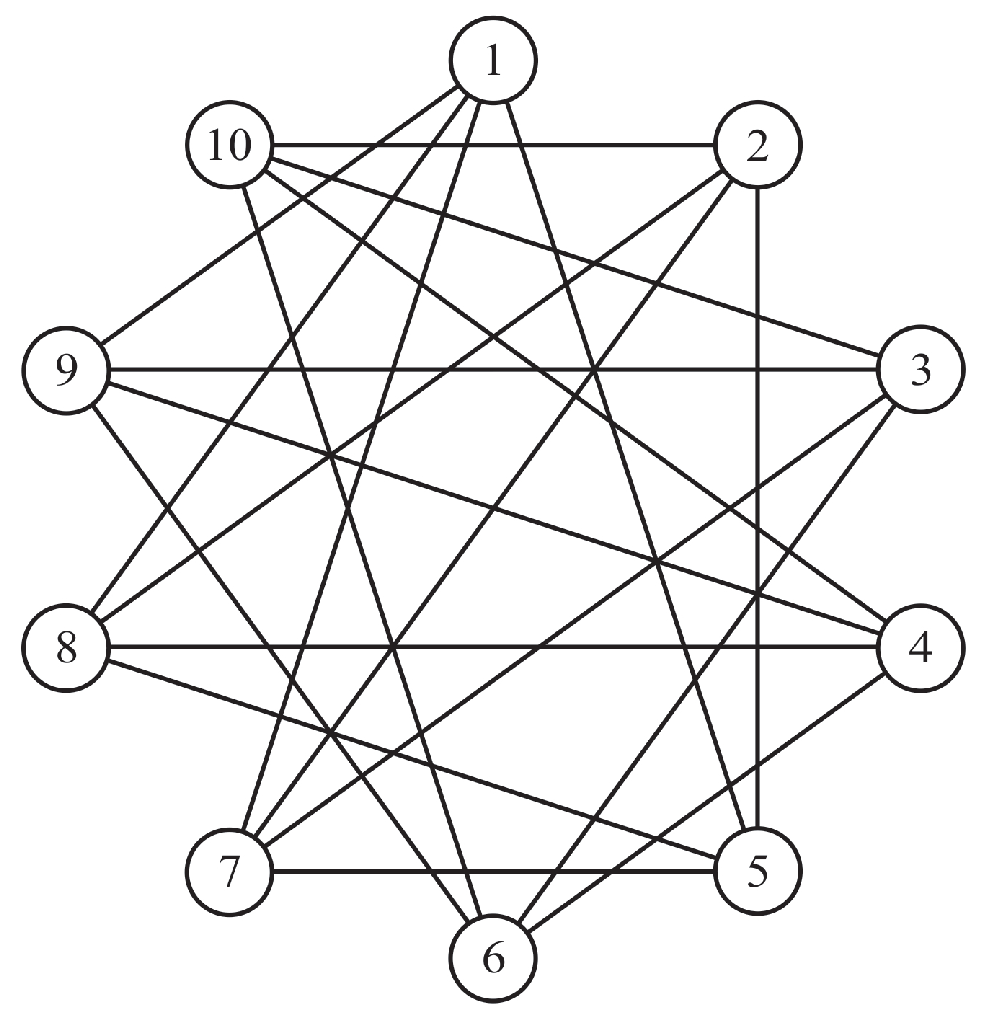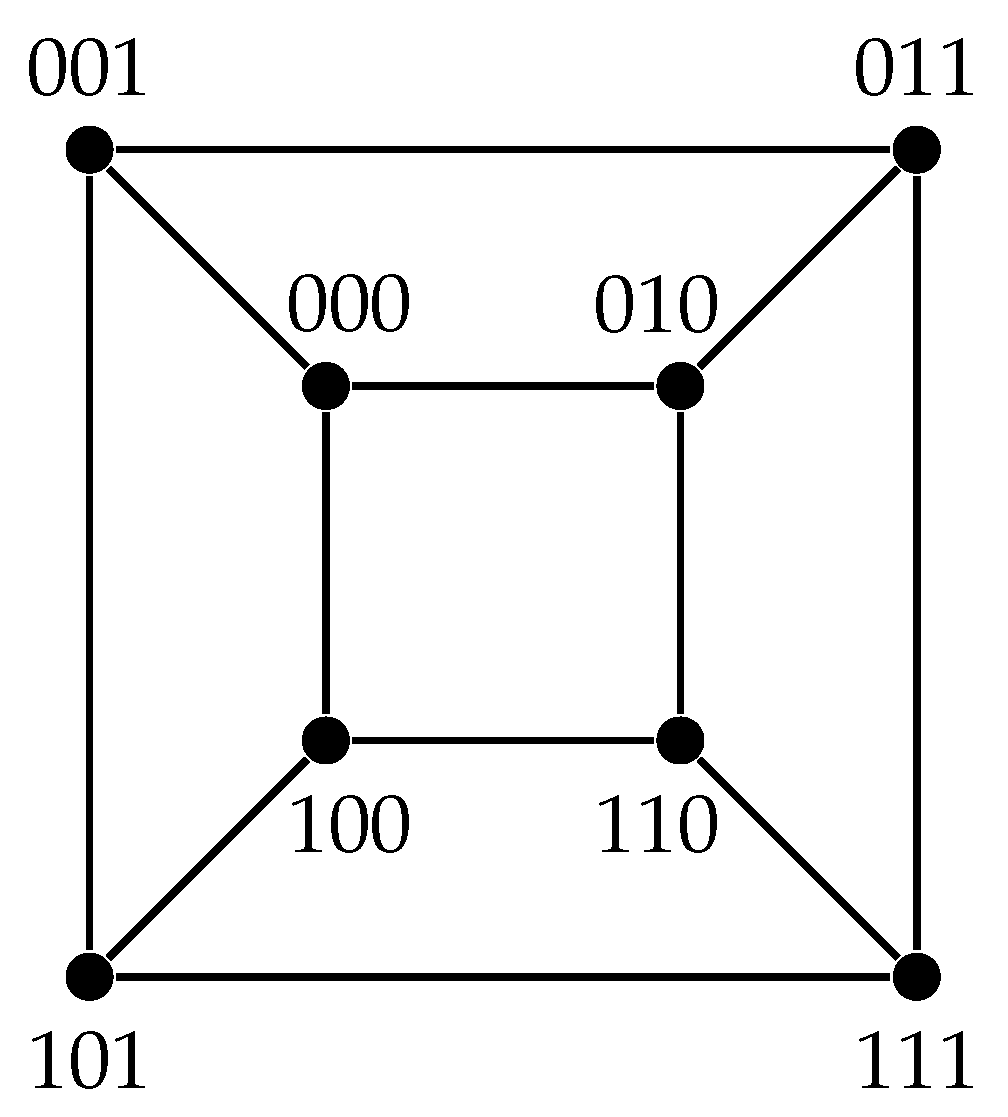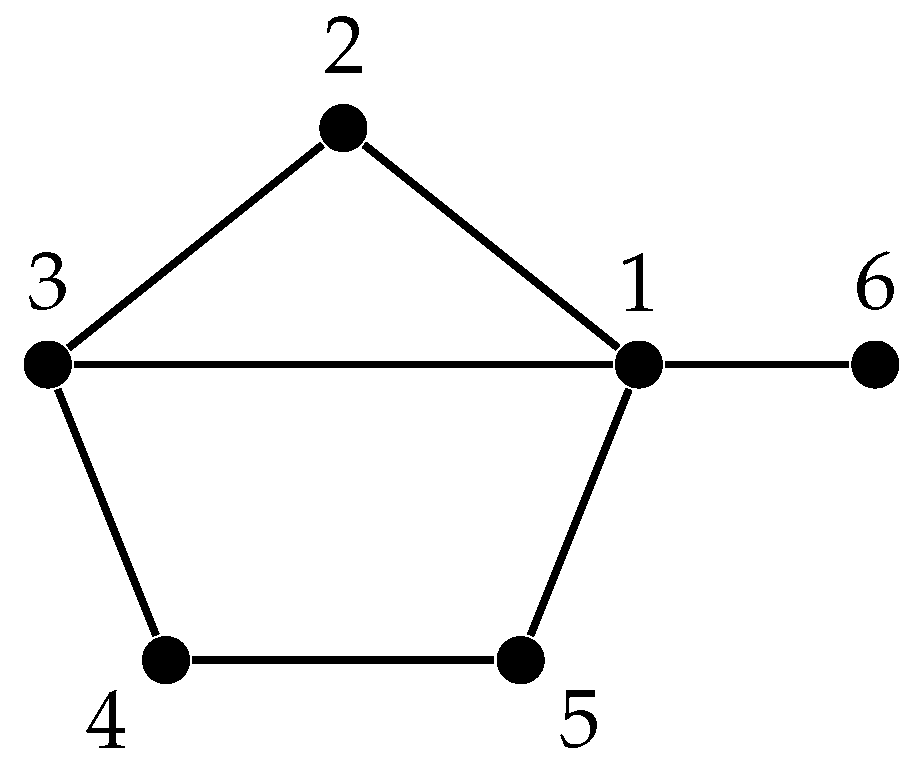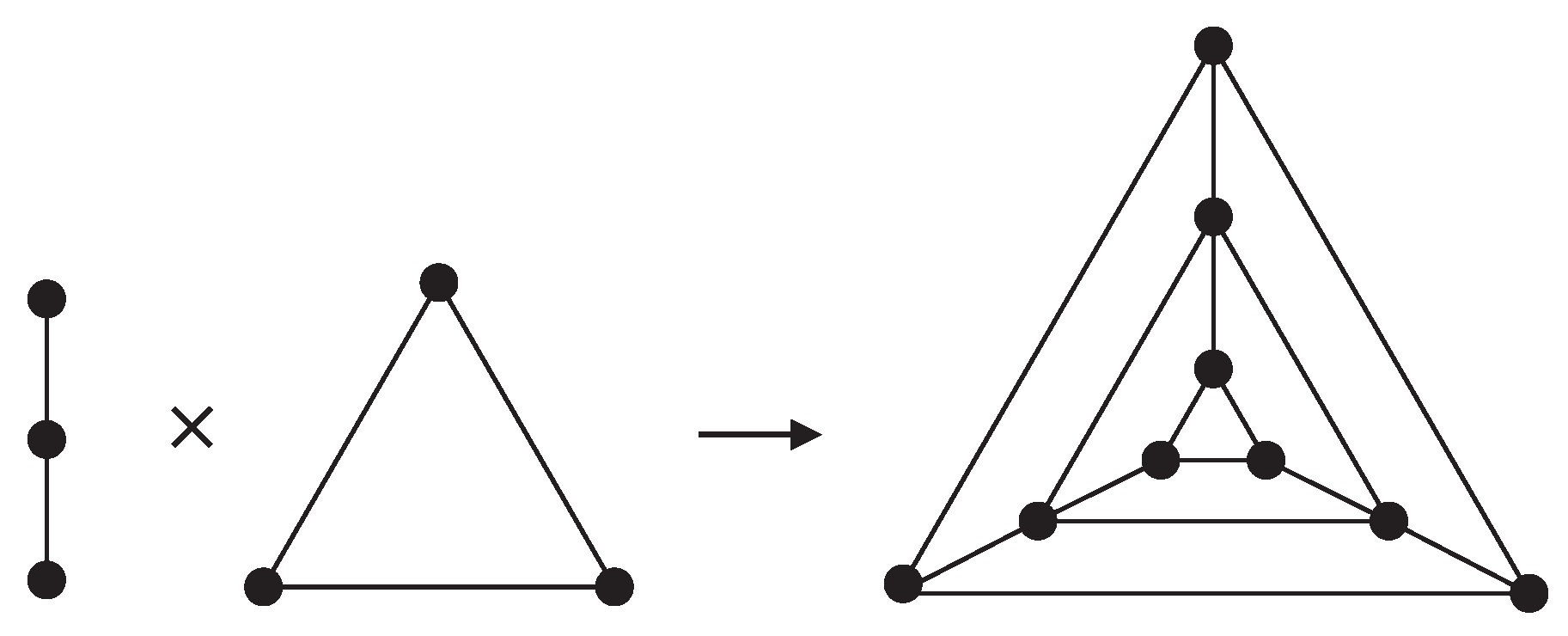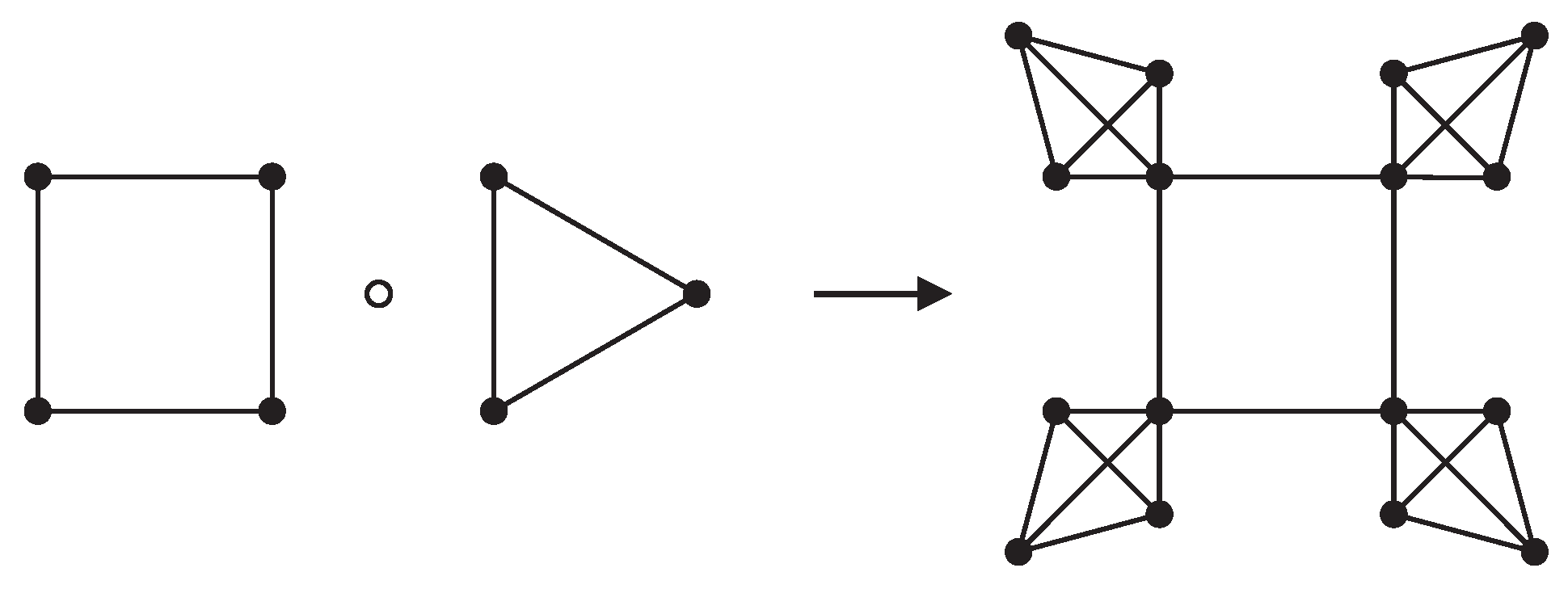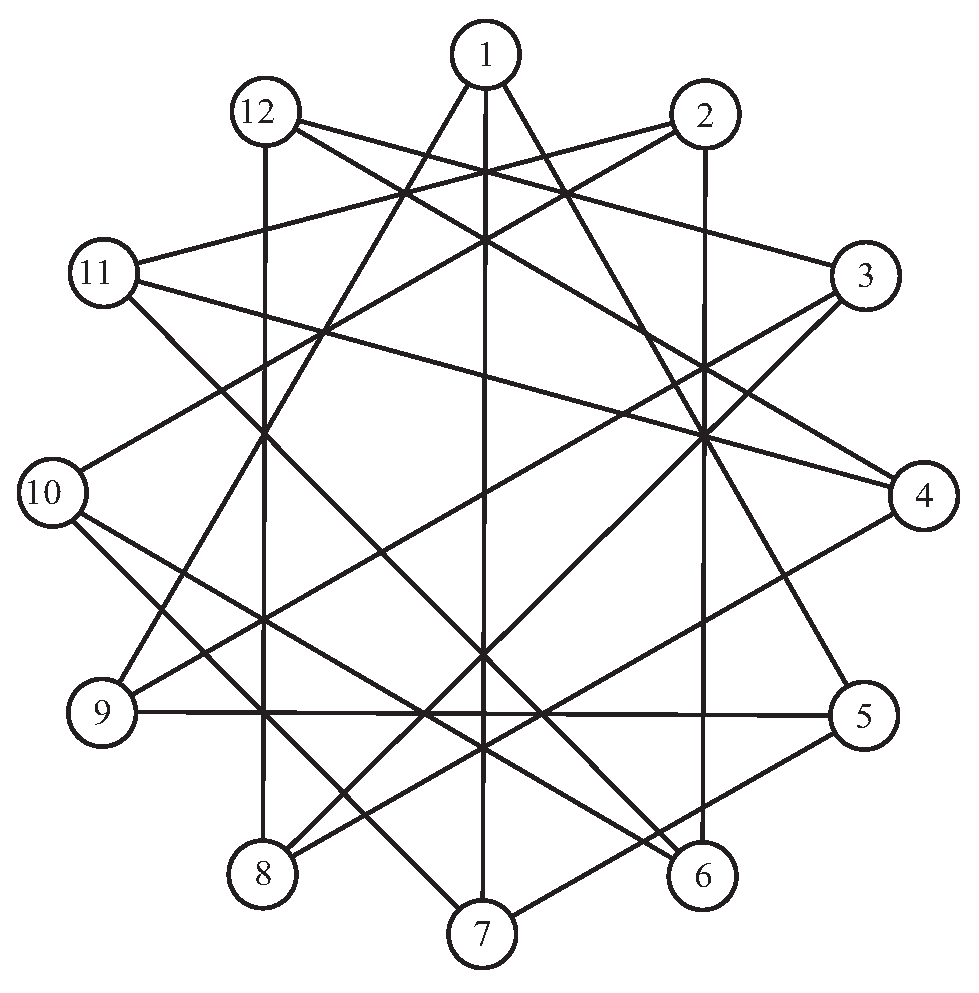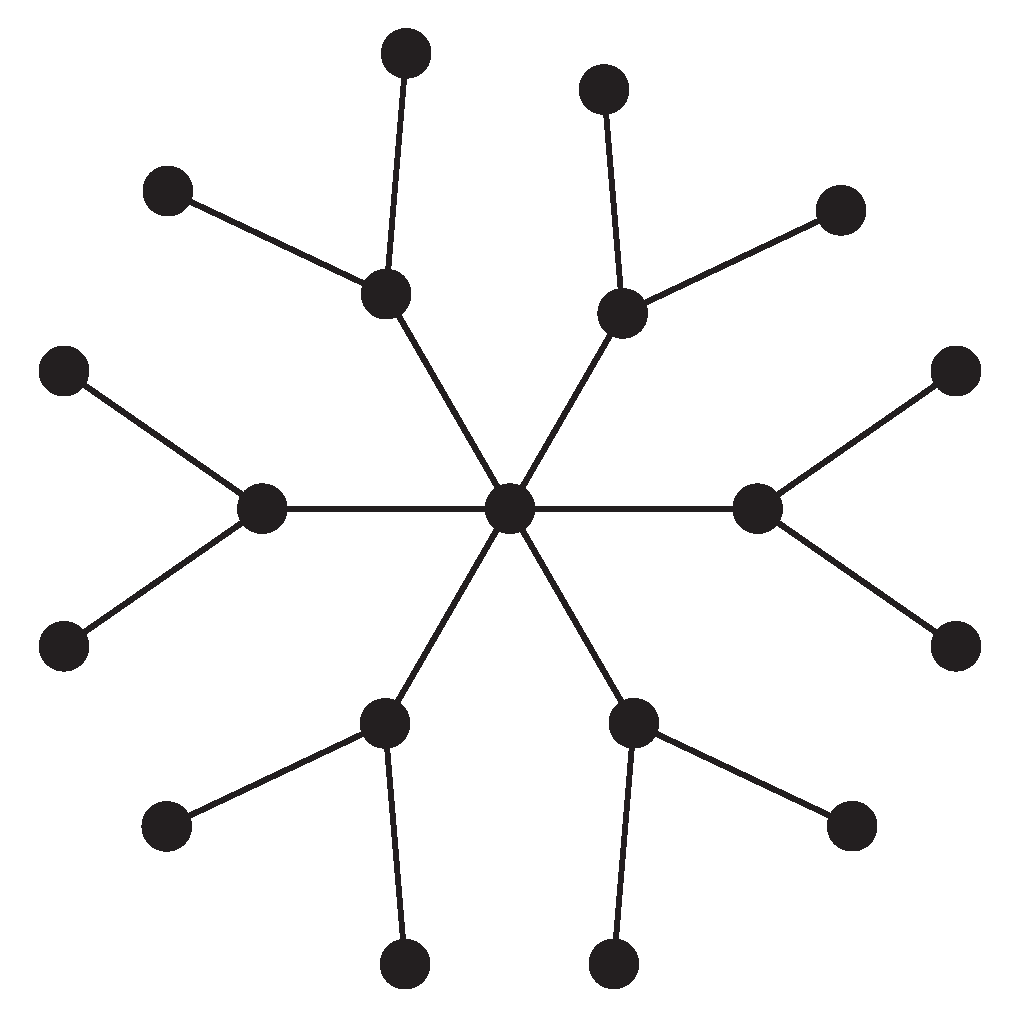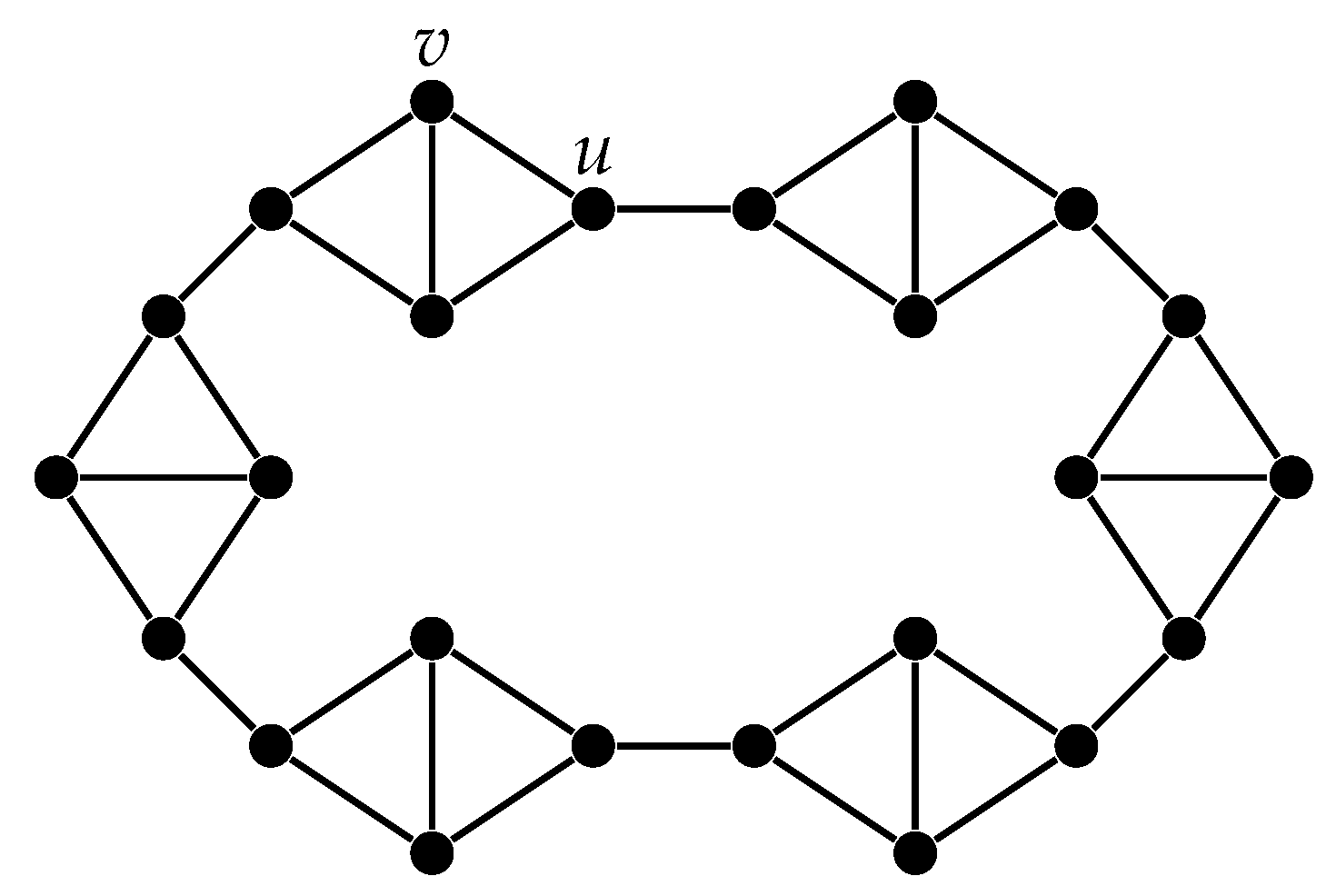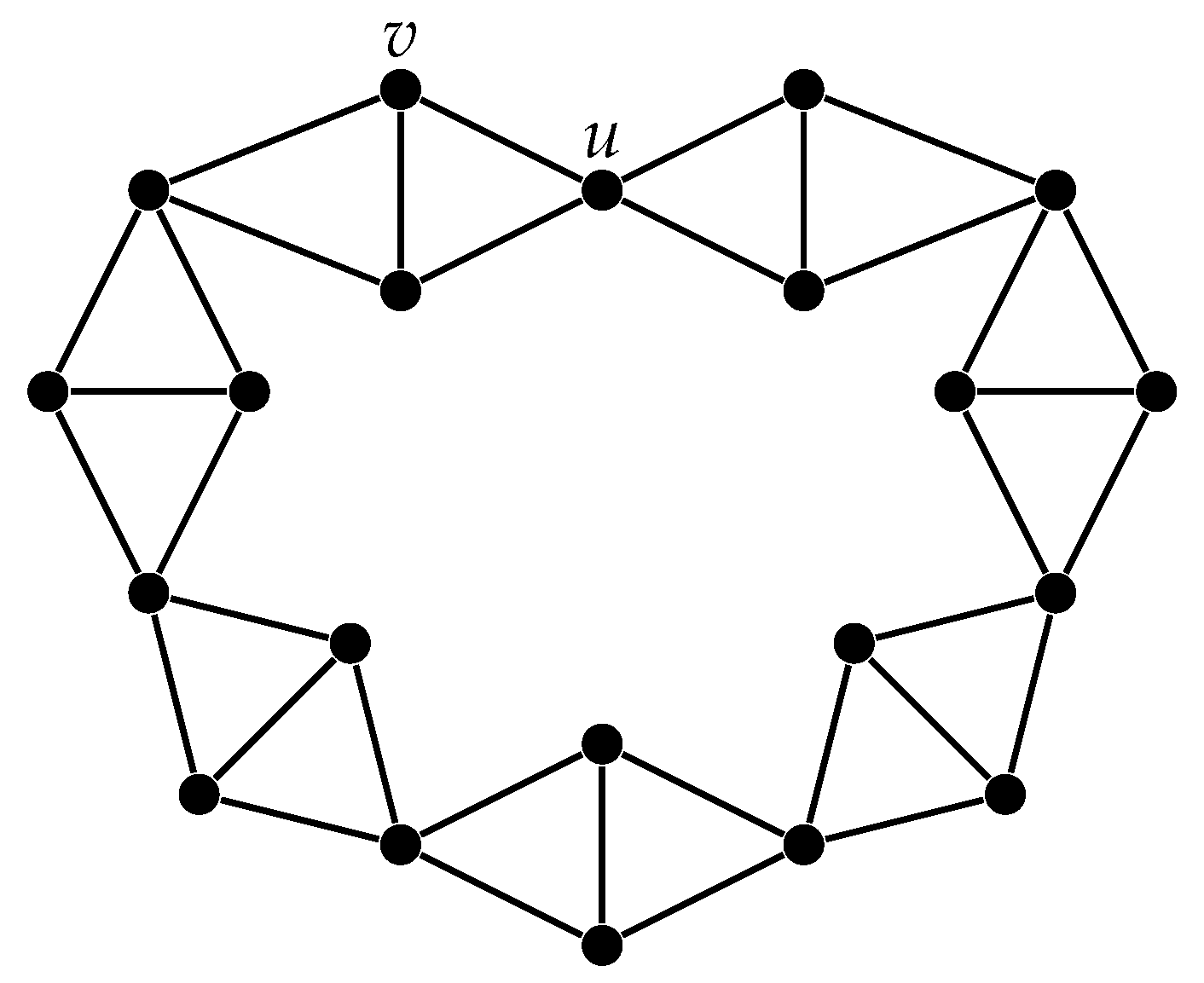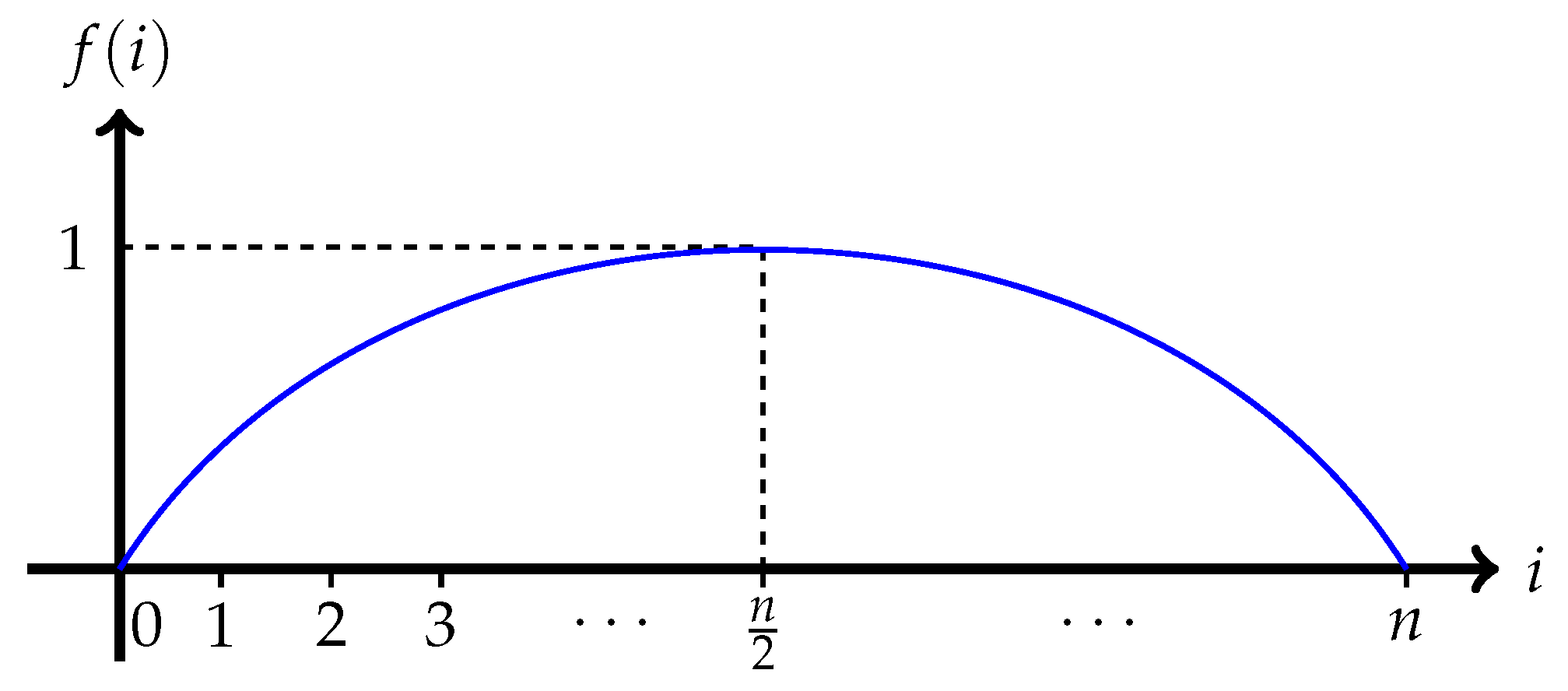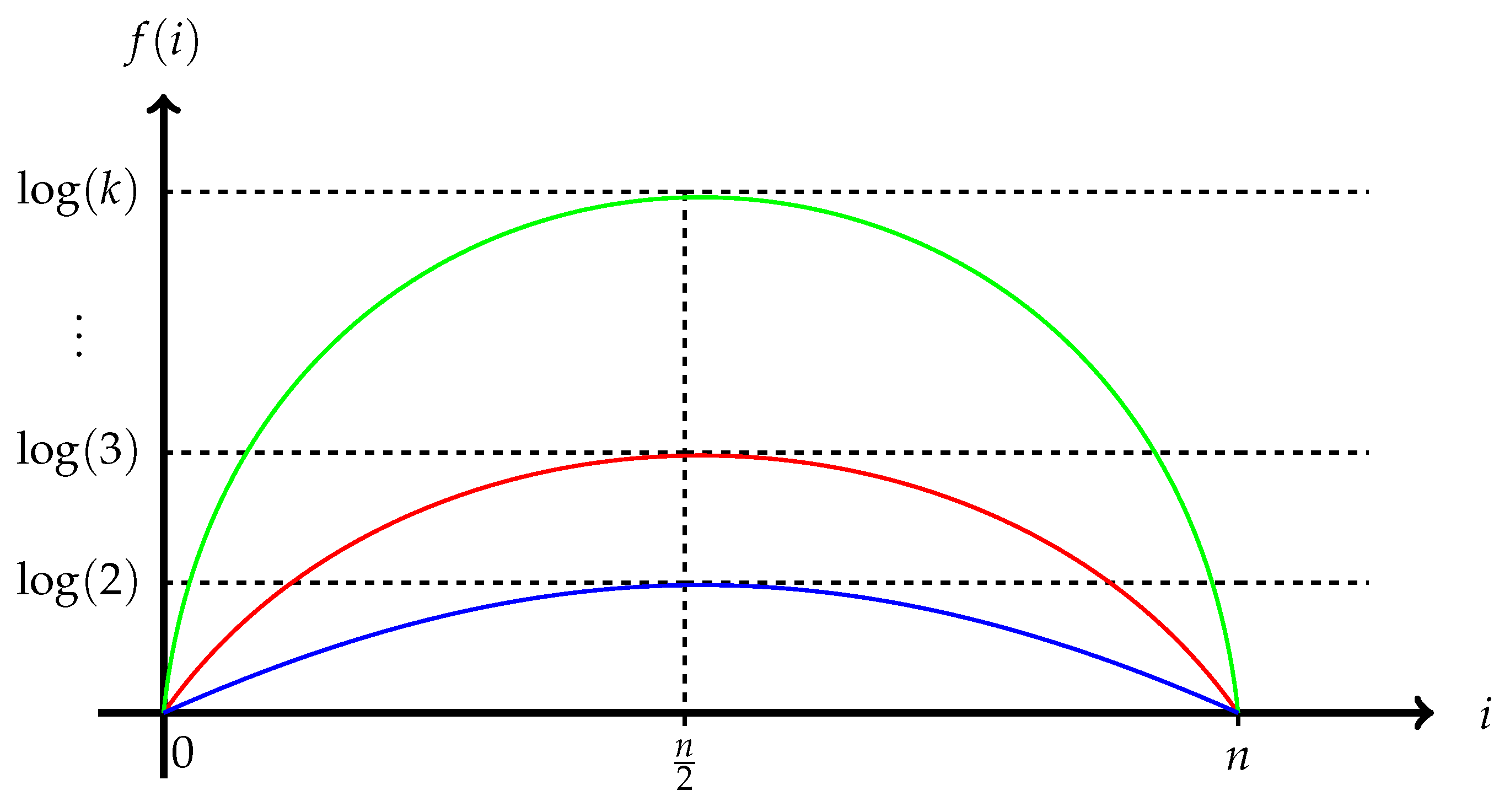The problem of computing
H-entropy, like that of determining the information content of a graph, requires a method for finding partitions,
H-partitions in this case [
8,
21]. In this section, we derive some basic properties of
H-entropy and determine this quantity for several classes of graphs.
3.1. Properties of the H-Entropy
As mentioned earlier, this paper focuses on properties of the H-entropy of graphs related to the number of orbits of the automorphism group. The H-entropy of a graph G is based on distance between vertices. For a vertex , the total distance of is defined as .
Theorem 1. If G is a vertex-transitive graph, then for all vertices .
Proof. For any two vertices
, given that
G is vertex-transitive, there is an automorphism
such that
. Hence
□
Corollary 1. Suppose u and v are in the same orbit of , then u and v are H-equivalent. If G is vertex-transitive, then .
Although, each pair of similar vertices (i.e., vertices in the same orbit) are
H-equivalent, the converse is not generally true. For example, the two vertices
u and
v shown in
Figure 1 are
H-equivalent, but they are in different orbits. Moreover, the condition
for two arbitrary vertices
does not guarantee that they are
H-equivalent.
Figure 2, gives an example in which
, but
u and
v are not
H-equivalent.
From Corollary 1, it is clear that if
G is a vertex-transitive graph, then
. However, there are many examples of non-vertex-transitive graph with zero
H-entropy, see for example the graph shown in
Figure 3.
Example 1. Let G be a finite group with binary operation ☆ and , a non-empty subset containing an inverse for every element but no identity element. The Cayley graph is a graph with vertex set in which any two vertices x and y are adjacent if and only if . Each Cayley graph is vertex-transitive and, thus, the H-entropy of X is zero. For example consider the cyclic group and suppose . The corresponding Cayley graph is isomorphic with the cycle graph . For more details about the Cayley graphs, see [22]. Example 2. A distance-transitive graph is defined as follows. For pairs of vertices and in , there exists an automorphism of the graph that carries u to x and v to y, whenever .
Every distance-transitive graph G is vertex-transitive and, thus, .
Example 3. Hamming graphs [23] constitute a special class of graphs used in several branches of mathematics and computer science. Let S be a set of q elements and n a positive integer. The vertex set of the Hamming graph is the set of ordered n-tuples of elements of S and two vertices and are adjacent if they differ in one position only. It is a well-known fact that all Hamming graphs are distance-transitive and, hence, . For example, the cube is a Hamming graph, see Figure 4. Recall the following theorem stated earlier.
Theorem 2 ([
8])
. If G is a regular graph with diameter , then . A regular graph with n vertices and degree k is said to be strongly regular if there are integers and such that every two adjacent vertices have common neighbors and every two non-adjacent vertices have common neighbors. The following result can be derived from Theorem 2.
Corollary 2. If G is a strongly regular graph, then .
Proof. It is well-known that each strongly regular graph is regular of diameter 2. The conclusion follows from Theorem 2. □
Theorem 3. Let G be a connected graph on n vertices with the maximum value of H-entropy. Then consists of the identity alone.
Proof. Let
be the set of all
H-equivalence classes of
G. By the definition of
H-entropy one can see that
Clearly,
reaches the maximum value
if
. Since for each
,
, we have
if and only if
, for
. Hence, Corollary 1 implies that all orbits of
are singleton sets and the assertion follows. □
The converse of Theorem 3 is not true. For example consider the graph
G shown in
Figure 5. Then
consists of the identity alone, but
, since 2 and 5 are in the same
H-partition.
Lemma 1 ([
8])
. If G is a connected regular graph of degree greater than , then . Theorem 4. Let n be an even number and G be an r-regular edge-transitive graph of order n, where . Then .
Proof. If
G is a regular graph of degree greater than
, then by Lemma 1 we infer
. Suppose
G is a regular edge-transitive graph of degree
. We claim that
G is vertex-transitive. On the contrary, suppose
G is not vertex-transitive. Then following [
22],
G is a regular bipartite graph of degree
, which implies that
G is isomorphic to
, thus contradicting our hypothesis. Hence,
G is vertex-transitive and the conclusion follow form Corollary 1. □
Theorem 5. Let G be a graph with at least five vertices that is edge-transitive but not bipartite, all of whose vertices are of odd degree. Then .
Proof. Similar to the proof of Theorem 4, one can show that G is vertex-transitive and the result follows from Corollary 1. □
3.2. H-Entropy of Product Graphs
In this section, we derive explicit formulas for the
H-Entropy of some well known graph products. Included here are the cartesian product, join, corona and lexicographic product. For detailed information about these graph products, see [
24].
Cartesian Product.
Given graphs
A and
B, the
cartesian product is defined as the graph on the vertex set
with
and
adjacent if and only if either (
and
) or (
and
). This operation is illustrated in
Figure 6.
Theorem 6. Let A and B be graphs in which a and x are H-equivalent in A, and b and y are H-equivalent in B. Then and are H-equivalent in .
Proof. Appealing to the definition, we conclude
where for
we have
Since,
a is
H-equivalent to
x, and
b is
H-equivalent to
y, the result follows. □
Corollary 3. Suppose and are H-equivalent in . If a and b are H-equivalent in A, then x and y are H-equivalent in B.
Proof. Suppose and are H-equivalent in . This means that for . Then if a, b are H-equivalent in A, Theorem 6 yields that and thus x and y are H-equivalent. □
Lemma 2 ([
24])
. Let A and B be graphs, satisfying . Then is isomorphic to . Theorem 7. Let A and B be two graphs and A be vertex-transitive, where . Then .
Proof. If
A is vertex-transitive, then
. Hence,
□
Join
The join
of graphs
A and
B with disjoint vertex sets
and
and edge sets
and
is the graph union
, where each vertex of
is adjacent with all vertices of
, see
Figure 7.
Let A and B be two r-regular graphs with n vertices. Then is -regular of diameter 2 and by Theorem 2, we infer .
Theorem 8. Suppose A and B are r-regular graphs. If vertices are H-equivalent, then
Proof. By definition, we get , for . From , we conclude that . Finally, implies . □
Corona
Let
A and
B be graphs with
and
vertices, respectively. The corona product
is a graph obtained from
A and
B by taking one copy of
A and
copies of
B and then joining each vertex from the
ith copy of
B with the
ith vertex of
A, see
Figure 8.
Let denote the vertex in the jth copy of B corresponding to vertex , and let represent the jth copy of B.
Theorem 9. Suppose A and B are two graphs with vertex sets and , respectively. Then
- (i)
If are H-equivalent, then in are H-equivalent.
- (ii)
If are H-equivalent, then in are H-equivalent.
- (iii)
If and , then in are not H-equivalent.
- (iv)
If are H-equivalent, then and are H-equivalent in .
Proof. - (i)
Let
be
H-equivalent. It is clear that
. For
and
, we obtain
So, . This means that for , we have .
- (ii)
Let
be
H-equivalent. Then
and
If
and
, then
This means that, Hence, for , .
- (iii)
Since the degree of each vertex in is greater than the degree of vertices in , they are not H-equivalent.
- (iv)
The proof is similar to the one of .
□
Corollary 4. The H-entropy of is greater than zero.
Proof. By Theorem 9, the vertices of A are not H-equivalent to the ith copy of B and thus there are at least two vertices and such that a and b are not H-equivalent in G. Hence, □
Lexicographic product
Let
A and
B be graphs having disjoint vertex sets
and
with
,
, and edge sets
and
with
,
. The lexicographic product or composition
of
A and
B is the graph with vertex set
, in which
is adjacent to
whenever
is adjacent to
, or
and
is adjacent to
, see
Figure 9.
Theorem 10. Let and be two vertices of . If and are H-equivalent in A and and are H-equivalent in B, then u and v are H-equivalent in
Proof. From the definition, if
and
, then
; and if
and
, then
. Also, if
,
This implies that
and if
, then
and the proof is complete. □
3.3. H-entropy of Graphs with Two Orbits
In this section, we trace implications of the conditions under which a graph has two vertex-orbits and at most two H-equivalence classes.
Definition 1. A graph G is called co-distant, if for every pair of vertices , u and v have the same total distance, i.e., .
It is clear that each vertex-transitive graph is a co-distant, but there are many classes of non-transitive co-distant graphs. Consider the graph
G in
Figure 10. This graph has two orbits namely
and
. The distance matrix of this graph shows that
and
while the
H-entropy of
G is 1.
Theorem 11. Let G be a graph with two orbits. Then or .
Proof. Suppose G has two orbits and . If is a H-partition of G, then clearly . If and are two distinct H-partitions, then . □
Corollary 5. Let G be a connected edge-transitive graph but not vertex-transitive. Then or .
Proof. Under the above conditions, one can prove that if , then G is bipartite and has two orbits that form a bipartition of . Applying Theorem 11 concludes the proof. □
Corollary 6. Suppose G is a graph whose H-entropy is zero. Then G is not a tree. More generally, G is a regular graph.
Proof. If , then by Theorem 11, H has only one H-equivalence class and thus for two arbitrary vertices , . Hence G is a regular graph and this completes the proof. □
Let
G be a graph with two orbits
and
, where
,
and
and
are not
H-equivalent. Since
, by substituting
and
in Equation 2, we have
Equation (
3) allows for proving the following result.
Theorem 12. Suppose G is a graph with two orbits and and with non-zero H-entropy. Then, if and only if n is even and .
Theorem 13. Let G be a regular graph with two orbits and , where the diameter of G is less than 4. If G is co-distant, then .
Proof. If , then according to Theorem 2, . Suppose G is an r-regular graph of diameter . Then the entries of the u-th and v-th rows of distance matrix are and , respectively, where a and b are non-negative integers such that . Since , we have which implies . This means that the number of 2’s and 3’s in the u-th and v-th rows of the distance matrix are the same and, thus, u and v are H-equivalent. □
3.4. H-Entropy of Trees and Graphs with Two Orbits
Let
and
be the star graph and the wheel graph on
n vertices, respectively. The bi-star graph
is a graph obtained from the union of
and
by joining their central vertices. Also let
be a tree with a central vertex of degree
n,
n vertices of degree
and
pendant vertices, see
Figure 11. Finally, suppose,
is a graph obtained from two copies of
by joining the central vertices.
Theorem 14 ([
24])
. Every tree T contains an edge or a vertex that is invariant under each automorphism of T. In what follows, a 2-graph is defined by having an automorphism group with exactly two orbits. A k-graph can be defined similarly.
Theorem 15. Let T be a 2-tree on n vertices. Then T is isomorphic to or T is isomorphic to , where .
Proof. Suppose has two orbits and T has a central vertex w. The central vertex forms a singleton orbit since for each automorphism , we have . But T has only two orbits, so the other vertices are in the same orbit. Since every tree has at least two vertices of degree 1, all vertices in the second orbit are pendant and adjacent to the central vertex. This means that T is isomorphic to . If T has a central edge, a similar argument shows that T is isomorphic to , where . □
Corollary 7. Let T be a 2-tree on vertices. Then one of the following cases holds:
- (i)
T is isomorphic to and .
- (ii)
, T is isomorphic to and .
Theorem 16. Let T be a 3-tree on n vertices. Then T is isomorphic to or T is isomorphic to .
Proof. Suppose T is a tree with a central vertex w. The other vertices of T include the pendant vertices and vertices of degree i, where . We know is a singleton orbit and the vertices of degree 1 also form an orbit. Hence, the other vertices necessarily have the same degree and constitute the third orbit. This implies that T is isomorphic to . If T has a central edge, a similar argument shows that T is isomorphic to . □
Theorem 17. Let G be a 2-graph with non-zero H-entropy. Then if and only if G is isomorphic to , where is a vertex-transitive graph.
Proof. If
, where
is a vertex-transitive, then
G has two orbits: A singleton orbit and an orbit of size
. The conclusion follows from Equation (
3). Conversely, if
then
Since
has two orbits and
is non-zero, the orbits and
H- partitions are the same and Equation (
4) implies that
and
which completes the proof. □
